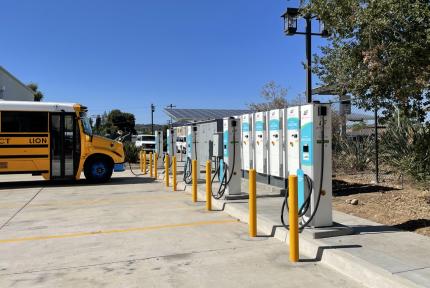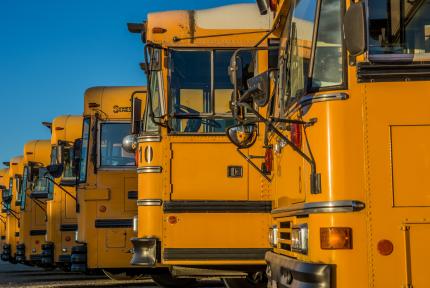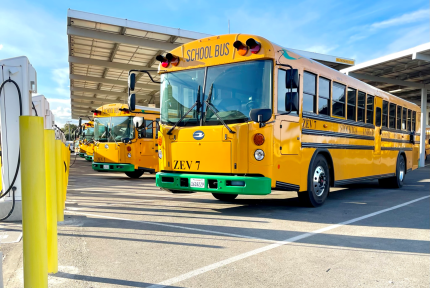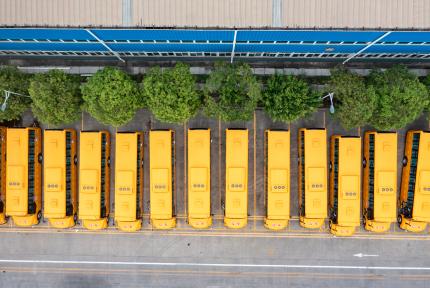All About Funding and Financing Options for Electric School Buses
The real cost of electric school buses is lower than you may think.
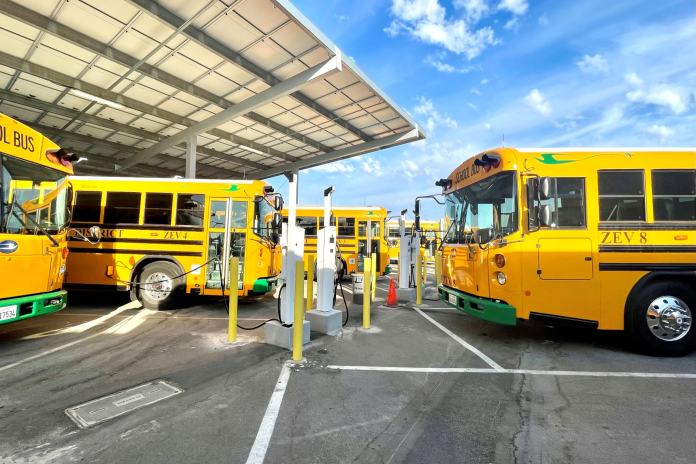
With zero tailpipe emissions, electric school buses (ESBs) offer the clean, healthy ride that every student deserves so they can arrive at school ready to learn. But the higher upfront purchase price of ESBs can pose a challenge to districts and private fleet operators interested in bringing the benefits of electric school buses to their communities.
Fortunately, over time the savings ESBs offer on operational expenses like fueling and maintenance add up and can offset the upfront purchase price of the bus. And as batteries become less expensive and the industry achieves efficiencies of scale in manufacturing in the second half of this decade, the total cost of ownership (TCO) – the combination of the initial purchase cost and costs over time – of ESBs is expected to equal that of diesel-burning school buses.
Once that happens, electric school buses can start to produce savings for school districts compared to the use of diesel-burning buses!
Additionally, with funding and subsidy programs available, many current ESB purchases already achieve lifetime cost savings or TCO parity with diesel-burning school buses. For school districts and fleet operators looking to take advantage of these savings, it is crucial to understand TCO, business model options, and how to find the right funding and financing options to help cover the upfront purchase price of an ESB. Here is what to know.
With subsidy programs available, the total cost of ownership for many electric school bus purchases is already on par with diesel-burning school buses.
Total Cost of Ownership
When thinking about the transition to ESBs, it is important to think beyond upfront purchase costs and instead consider the lifetime costs associated with owning and operating a school bus. In many cases, the total cost of ownership (TCO) for ESBs – including both the upfront purchase cost and the cost of operating the bus – shows that ESBs are no more costly than diesel-burning school buses.
And if funding or incentives are applied, the TCO for electric school buses can actually be lower than for diesel-burning school buses, allowing school districts to save money and reinvest in the classroom.
Some helpful resources for school districts to conduct TCO analysis include:
- The Electric School Bus Initiative’s All About Total Cost of Ownership (TCO) for Electric School Buses, which gives an overview of electric school bus TCO considerations and assumptions, presents illustrative TCO scenarios, and provides TCO analysis tools for school districts
- The Electric School Bus Initiative’s Total Cost of Ownership Calculator for Electric School Buses, which allows school districts to estimate an approximate TCO for their electric school buses based on local circumstances, and easily compare with the TCO for diesel-burning school buses.
Types of funding and financing
There are more funding and financing opportunities available to school districts than ever before to help offset the purchase price of bringing clean rides to students. Funding and financing from the federal government, state governments, electric utilities, green banks and local agencies can all help reduce the TCO of electric school bus ownership and make ESBs a more affordable option.
Funding mechanisms include:
- Grants: awards made to qualifying applicants, for a specific purpose or use case, deemed the worthiest based on a set of criteria. For example, Environmental Protection Agency’s (EPA) Clean School Bus Program (CSBP) awarded grants for new ESBs to eligible applicants in 2023.
- Rebates: reimbursements after certain eligible purchases of pre-approved equipment. For example, EPA’s CSBP also has awarded funds in the form of rebates.
- Vouchers: credits applied “on the hood,” immediately at purchase, that lower the price paid by the recipient. For example, New York State Energy Research and Development Authority (NYSERDA) oversees the NY School Bus Incentive Program (NYSBIP) which awards vouchers on a first-come, first-served basis to eligible applicants.
- Tax Credits: credit toward tax liability for purchases of electric school buses and infrastructure; as tax-exempt entities, school districts may be able to access these tax credits as a direct payment. For example, the Inflation Reduction Act Of 2022 included two tax credits school districts and contractors can utilize for purchase of a new ESB and related charging infrastructure: Qualified Commercial Clean Vehicles (45W) and Alternative Fuel Refueling Property (30C). However, the budget reconciliation bill signed into law in July 2025 eliminated the use of the 45W and 30C tax credits, which are included in these parameters, after certain dates. The 45W credit was eliminated for any vehicle acquired after September 30, 2025, and the 30C credit will be eliminated for refueling property (including electric vehicle charging installations) placed in service after June 30, 2026. On August 21, 2025, IRS provided new information about the term "acquired."
Where funding opportunities do not meet the full ambition of a school district's plans, districts should consider various financing opportunities. Mechanisms include:
- Loans and tax-exempt lease-purchases: financial arrangements where a public or private entity provides funds with the expectation of repayment over a specified period of time; terms and conditions are usually set by the lender
- Bonds: (in most cases) a municipal bond is issued by a school district to raise funds from the public to finance educational infrastructure, usually repaid through future tax revenues or other specified revenue sources and typically needs to go to the voters for approval
- Operating leases: financing through operating lease contracts directly with OEMs or dealers, which can include an option to purchase the asset after leasing term is complete
There is a bevy of funding and financing mechanisms and the above list is not comprehensive. You can find more information on mechanisms in the Electric School Bus Initiative’s article, Powering Electric School Bus Adoption with Complementary Funding and Financing Solutions. To find specific funding and financing programs check out the Electric School Bus Initiative’s Clearinghouse of Electric School Bus Funding and Financing Opportunities.
The section below shares resources school districts can use to explore these and more funding and financing opportunities.
There are more funding and financing programs available to school districts than ever before to help offset the purchase price of bringing clean rides to students.
Finding the right funding and financing option
For school districts seeking to electrify a substantial number of buses, it is helpful to understand the range of options and opportunities for leveraging multiple funding sources, where they may exist and the best strategies for accessing support. Some helpful resources include:
- The Electric School Bus Initiative's Clearinghouse of Electric School Bus Funding and Financing Opportunities, which lists the type of funding or financing, program eligibility, funding levels, and more
- The Electric School Bus Initiative’s Powering Electric School Bus Adoption with Complementary Funding and Financing Solutions article, which demonstrates the benefits of pairing funding opportunities with financing to either fill gaps in funding or scale the electrification project
- The Electric School Bus Initiative’s How to Help Your Community Fund Electric School Buses in the US article, which outlines some of the ways communities can fund electric school buses, including federal, state, local and utility programs
- The Electric School Bus Initiative’s Electric School Bus Funding and Financing 101 Slide Deck, which provides an introductory overview of costs, barriers, and various funding and financing tools districts can mechanize to achieve school bus electrification
Picking the right electric school bus business model for your situation
With more interest than ever in electric school buses, school districts and fleet operators are considering new, distinct business models. To understand business model options, districts need to identify the assets (buses and infrastructure) and associated roles of bus electrification, consider ownership options and stakeholders, and weigh their appetite to absorb risk and make the most of opportunities.
The key roles include:
- Bus owner: entity that holds bus on books as capital asset
- Energy/fuel manager: entity that provides charging/energy management services
- Bus maintenance provider: entity responsible for vehicle service
- Bus operator: entity that operates buses (e.g., provides drivers)
- Charger owner: entity that holds charger on books as capital asset
- Electricity customer: entity that covers electricity cost
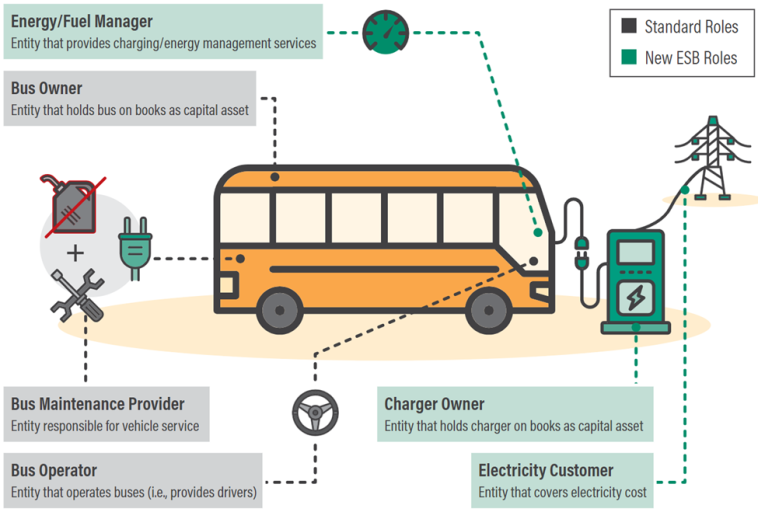
There are various entities that could fulfill each role, with potential benefits and tradeoffs to each approach. It can be complicated to navigate the roles and business models that can enable school bus electrification – some helpful resources include:
- The Electric School Bus Initiative’s All About Electric School Bus Business Models article provides a high-level overview of the electric school bus business model landscape
- The Electric School Bus Initiative’s Electric School Bus Business Models Guide defines key electric school bus roles, presents benefits and considerations that districts can weigh when assigning responsibility for each role, and lays out a framework for the business models that result from assignment of these roles
- The Electric School Bus Initiative’s School Bus Electric-as-a-Service (EaaS) Directory helps school districts identify and connect with firms that provide electrification services to support whichever business model is appropriate for their particular context
- The Electric School Bus Initiative’s Electric School Bus Business Models 101 Slide Deck provides an introductory overview of the various business models in the electric school bus market school districts can explore when considering electrification
To stay in the loop on the latest electric school bus resources, including new funding and financing information, be sure to sign up for email updates from the Electric School Bus Initiative.

